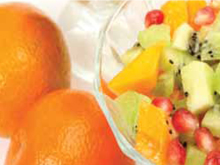Health Topics
-
Healthy Living
-
|
|
April 2011
|
| Diabetic Diet for Non-vegetarians |
| Rekha Yadav |
| |
 |
Diabetes needs no introduction. It is a disease about which we all keep hearing and reading from time to time. It is a metabolic syndrome, which is controllable by making changes in one’s lifestyle and dietary habits. Diet plays a key role in the management of diabetes. People who have diabetes are often advised to take a diet rich in fibre. When we say fibre, we mean fruit, vegetables, whole grains and pulses. |
The Non-vegetarian’s Dilemma
But what if a person who has non-vegetarian food habits is diabetic? Should that person just change his or her dietary habits and become a complete vegetarian? Well my answer would be no, he doesn’t need to change his habits completely. A non-vegetarian person can also manage diabetes following some simple tips to control his or her diet and lifestyle.
What You Eat
In a vegetarian diet, one avoids refined cereals and high fat foods. The same is recommended in a non-vegetarian diet. Non-vegetarian foods that are high in fat like red meats should be avoided as much as possible. Although red meats are a great source of protein, vitamin B12, and minerals, they also contain saturated fats that are not good for us. As a replacement, use lean mutton to reduce the amount of saturated fat intake. Chicken is high in protein, but you will need to remove the skin from the chicken to avoid the saturated fat. One must try to include fish in the diet. Eating fish provides polyunsaturated fats that are required by the body, along with the omega-3 essential fatty acids. Variation is the essence, when it comes to protein foods for diabetics. The cooking method also plays a key role in managing diabetes. A deep fried food is rich in calories and should be avoided to keep those extra calories away. Steamed, baked, roasted or grilled products make use of less or no oil while cooking; so such methods should be preferred for cooking of non-vegetarian foods.
When You Eat
Having five to six small meals is always better than having three large meals. Eating a small meal will prevent sudden rise in blood glucose levels, giving your body time to process the carbohydrates present in your food. Frequent meals help to avoid hypoglycemia, or low blood sugar. Healthy non-vegetarian snacks like a chicken or turkey sandwich are a good way to bridge the gap between meals.
How Much You Eat
One of the most important aspects of a diabetic diet is the portion size of the food that you eat. Food exchange lists can be used while substituting a vegetarian food with a non-vegetarian food. The main purpose of using a food exchange list is to make sure that while eating non-vegetarian food you do not go overboard with any particular nutrient and your calorie intake remains almost the same. A bowl of dal is giving you proteins plus fibre, but when you replace it with some chicken or fish, you are reducing the fibre and increasing the protein, thus the portion of food needs be reduced to manage the proteins and calories. Along with that, fibre from fruit or salad needs to be added to the diet.
Right Calories and Fibre
Non-vegetarian food is not harmful for a diabetic person; provided the above points are taken care of and the very important Mr. Fibre is not forgotten. A diabetic diet is simply a healthy eating plan that is high in nutrients, low in fat, and moderate in calories. It is a healthy diet for anyone. So in conclusion, I can say that meats and seafoods are as good for diabetics as any other food item, provided the very important fibre from vegetarian diet is included in the meal and the calorie intake remains the same as for a vegetarian diet.
|
Rekha Yadav is Lifestyle Counsellor, Apollo Life, New Delhi
|
|
|